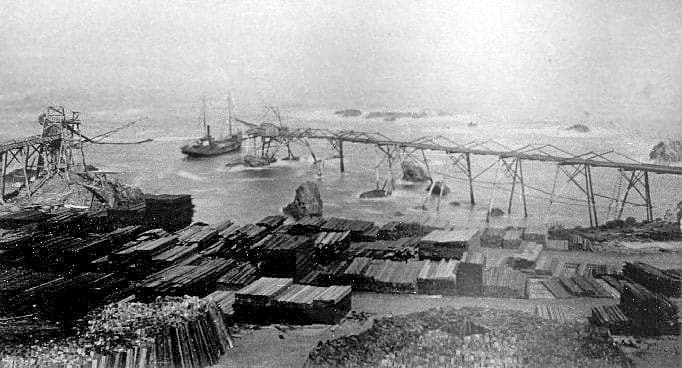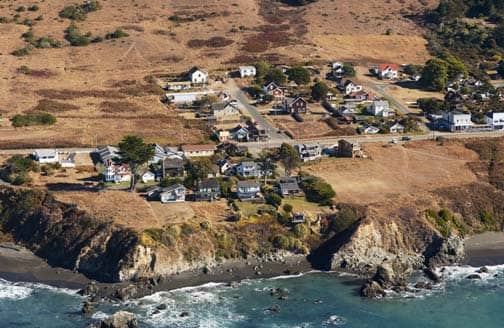WESTPORT - MENDOCINO COAST
WESTPORT HISTORY
History of Westport
By Robert Lorentzen
Westport started out as Beall’s Landing around 1864, settled by Samuel and Lloyd Beall, formerly of Little River, Bridgeport and Mendocino. While very little information exists about Westport’s early days, we know that E. J. Whipple of Ten Mile and Lloyd Beall were partners, acquiring land here by 1860. Beall built a loading chute around 1864. Alfred Wages settled along the creek to the north about the same time.
We also know that Captain M. C. Dougherty, an employee of the Mendocino Indian Reservation, started cutting timber on the hill east of town in the last half of that decade. He apparently used the timber to build a chute for shipping potatoes. While potatoes were an excellent cash crop in those days, the town’s future was not to be in spuds.
Other men attempted to build more elaborate chutes to load ships beyond the dangerous rocks offshore. But only after James T. Rogers moved to the area in 1877 and built the town’s first wharf, did this part of the coast begin to prosper. Constructed at great cost and requiring considerable engineering, Rogers’ wharf was 380 feet long, with a chute at the end. By the end of 1877 Rogers named the landing Westport because the area reminded him of his home town of Eastport, Maine, on the New England Coast.
Rogers soon constructed a second (north) wharf 610 feet long, capable of handling 150,000 board feet of lumber each day, turning Westport into a boomtown. A hotel, saloon, post office and general store soon joined the blacksmith shop and ranches that had already grown up here.

By 1881 Westport sported two mills on Wages Creek, three hotels, six saloons, two blacksmith shops, three stores, two livery stables, two shoe shops, a barber shop, butcher shop, post office and telegraph office. By 1883 a stagecoach ran between Ukiah and Westport, with stops at Kibesillah (later at Fort Bragg) along the way. The coach left at sunrise and took all day to traverse the rugged country on rough roads. Westport soon boasted a population of 400, with around 65 ships loading at the chutes each year. One account claims Westport had 14 saloons in its heyday.
Tanbark, shingles, wool, oats and railroad ties rounded out the town’s early exports. The wharves and chutes needed constant repair in winter, the price of their exposure to the brunt of coastal storms. Ship captains were at first reluctant to call at Westport because of the treacherous seas among the many offshore rocks. The south wharf, abandoned by 1900, was down Omega Street from today’s store, while the north wharf was at the north end of Omega Street.
While Westport’s timber enterprises struggled through boom and bust in the last two decades of the nineteenth century, the area’s ranches continued to prosper.
Everyone struggled through the Great Depression of the 1930s. While some sold out and moved on, many others stayed to run the proud, isolated community. By 1952 many buildings had been consumed by fire, others died of neglect. The mills had closed as trucks and improved roads allowed the cut timber to be hauled to the big Union Lumber Company mill at Fort Bragg.
Westport today may be only a shadow of its heyday, but at least the town survives, unlike a dozen other lumber towns up and down the coast, where nothing but a leaning barn or ranch house mark the days of prosperity and tight-knit community.

